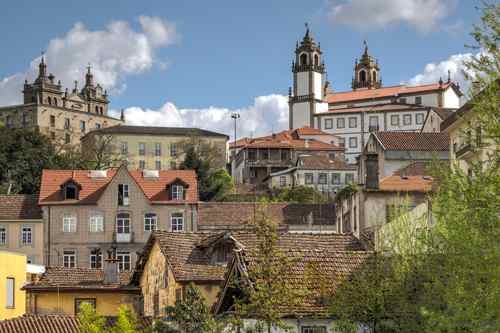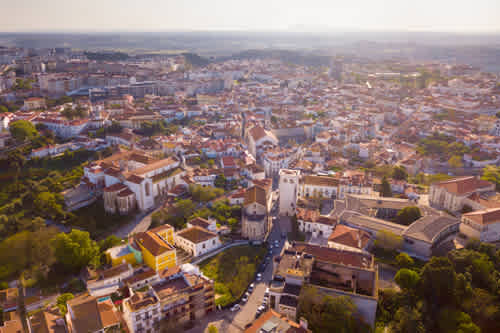About Portugal
Portugal… a land of medieval castles, cobblestoned villages, fascinating cities, golden beaches, extensive cultural heritage, superb cuisine and wine, and spectacular views.
Along the country’s approximately 500 miles of coastline you’ll find untouched nature - towering cliffs, awesome surfing waves which break onto the dunes, and white sand beaches with turquoise waters.
Portugal’s total area is close to 35,000 square miles, and it forms the westernmost border of Europe. Located on the Iberian Peninsula’s Atlantic coast, its geographical location led it to become one of the most powerful seafaring nations in the medieval world.
Portugal’s highest mountain range, the Serra da Estrela, is home to a 343 square mile park – a perfect spot for hiking and climbing in the warm months and skiing in the winter. The park is breathtakingly beautiful with lakes, rivers, forested valleys, and charming villages. Portugal’s highest peak, the Torre, is located here, and, its 19th century tower (torre in Spanish) offers spectacular views extending far into the distance.
While Northern Portugal is mostly mountainous, the Douro Valley, which runs alongside the Douro River, is a highlight of the area. Often referred to as the “enchanted valley,” the Douro Valley is extraordinary with magnificent landscapes, steep slopes, historic landmarks, outstanding hotels and cuisine – and, last but not least, its renowned Douro (port) wines. The area is dotted with lush orchards and vineyards, and don’t miss a visit to the wineries – including the luxury wine tastings!
Portugal’s south is characterized by vast lowlands, cork oak forests, and some of the most beautiful beaches in the world. The architecture features Moorish influences - white villages, arched houses, low domes, and flat roofs.
In Eastern Portugal, the mountains are dotted with castles and fortress cities – testimony to the years of war in the region.
Lisbon, Portugal’s hilly, coastal capital, is a charming city nestled on seven hills. It is one of the oldest cities in the world – in fact, it is the oldest in Western Europe, predating other capitals by centuries. Lisbon is home to rich culture, beautiful beaches, narrow cobbled streets, delightful restaurants - and a vibrant nightlife. Visit the imposing Castelo de Sao Jorge castle which dates back to the 12th Century and the Torre de Belem fort with its iconic watch towers, breathtaking views, and scenic parks. Torre de Belem is a magnificent example of the unique late Gothic architecture of the time called Manueline- named for the 16th century monarch, King Manuel I. Go bargain hunting In the Feira de Ladra, Lisbon’s famous market, and don’t forget to sample one of the Pastel de Nata custard tarts that Lisbon is famous for.
Porto, Portugal’s second largest city, is situated on the coast, as well, and features an abundance of incredible museums, Roman ruins, and medieval buildings. Many of the buildings are adorned with mosaics and azulejos –tin-glazed ceramic tilework distinctive of this region. The Clerigos Tower, a 246- foot bell tower, is the city’s most iconic silhouette and offers amazing panoramic views from the top of its 225 steps. The Crystal Palace Gardens offer an exotic paradise of flora. The palatial 19th-century Palácio de Bolsa, formerly a stock market, is another historical highlight in Porto. A trip to Porto isn’t complete without a visit to the nearby Porto Wine Cellars to learn about and sample the many varieties of the famous port.
And now a brief recap of Portugal’s captivating history… Celtic invaders mixed with the ancient tribes of Iberia and created a Celtic-Iberian culture. The Romans, who added the Iberian Peninsula to their empire in the 2nd century BC, called their descendants Lusitanos. With the fall of the Roman Empire, Gothic invasions began, but, in 711, the Muslims conquered Portugal from the Visigoths and ruled the country for over 400 years.
Arab Moorish heritage, both architecture and culture, have survived through the centuries and their influence is unmistakable in many areas - the domed white houses, small windows, flat roofs, inner courtyards designed for life in a hot climate, and the Azulejo tiles that adorn private homes as well as churches, palaces, and other public buildings.
The Muslim rule lasted until 1139 when they were overtaken by Alfonso I who became the first king of Portugal.
Portugal’s power peaked in the 14th century during the time of King Denis who strengthened his country by building and fortifying a chain of fortresses along the Spanish border. He also founded the University of Coimbra, which became one of the most important educational institutions in Europe, and established the dialect spoken in the Porto region as an official spoken language, from which modern Portuguese grew.
It is impossible to talk about Portugal without referring to the 15th century period of prosperity and the Age of Discovery - also known as the “Age of Exploration.” During this time, Portuguese explorers were at the forefront of discovering new routes and untouched parts of the world. Henrique the Navigator initiated several famous voyages of discovery, including to the Madeira Islands and the Azores. Gil Eanes discovered the passable route around Cape Bojador – a major discovery for European traders along the route to Africa and India. Bartolomeo Diaz sailed around the Cape of Good Hope in 1487, establishing the sea route between Europe and Asia. In 1498, the explorer, Vasco da Gama, was the first to reach India by sea, Pedro Cabral discovered Brazil in 1500, and the Portuguese Magellan led the 1519 Spanish expedition to the East Indies and, in the course of the voyage, completed the first European navigation from the Atlantic to Asia.
During the 15th and 16th centuries, Portugal maintained its position as an international trading power. Under the rule of King Manuel I, the unique late Gothic architecture which came to be known as “Manueline” flourished, some of which remains today. The architecture is characterized by curled, exotic carvings depicting ships, sea creatures, shields, and other objects which are symbolic of nobility or related to seafarers. In addition to the Torre de Belem (the Belem Tower) and the Jeronimos Monastery located in Lisbon, the famous Unfinished Chapel in the Monastery of Batalha in Central Portugal is another primary example of this architectural style.
Portugal began to lose its powerful status after the Battle of the Three Kings in 1578. During the battle – a crusade against the Muslims in Morocco - the Portuguese King Sebastian was killed along with a large part of his army. Following the battle, Portugal was united with Spain for a period of 60 years.
In 1640, Portugal again became an independent country, but it never regained its status as an economic superpower. It lost several colonies, including Brazil in 1828, and Angola, Mozambique, and other African colonies –including Timor in the West Indies- at the end of the 20th century. Today, only Madeira and the Azores Islands remain under Portuguese control.
The monarchy in Portugal ended in 1910 and a Republic was created, but, due to its corruption and instability, the regime was overtaken by a military coup in 1926. A period of authoritarianism ensued, with a fascist- like regime, which lasted until the April 1974 Carnation Revolution – a military coup by left-leaning military officers. Following the coup, Portugal transitioned peacefully to a democratic system of government.
And now back to Portugal, the popular tourist destination. With a combination of rich culture and history, breathtaking natural beauty, outstanding wines and cuisine, international festivals, and mild temperatures, you’ll understand why Portugal is high on so many travel bucket lists!
Popular Itineraries
Traveled by thousands
Regions in Portugal
Attractions in Portugal
- Historic Center, Albufeira
- Beach, Ericeira
- Alcobaca Monastery
- Rock Beach, Portimao
- Historic Center, Alcobaca
- Town Center, Almancil
- Batalha Monastery
- Historic Center, Batalha
- Convent of Our Lady of the Conception, Beja
- Historic Center, Beja
- Biscainhos Museum, Braga
- Braga Cathedral
- Sanctuary of Our Lady of Sameiro, Braga
- Beach, Figueira da Foz
















